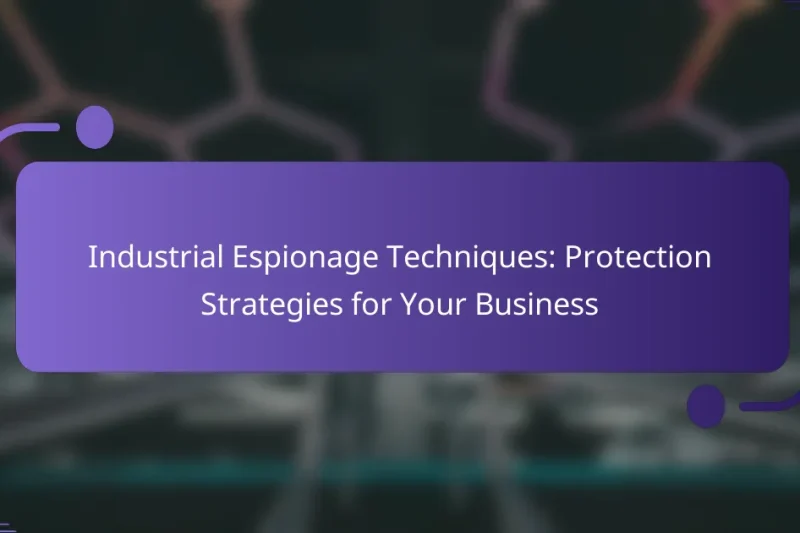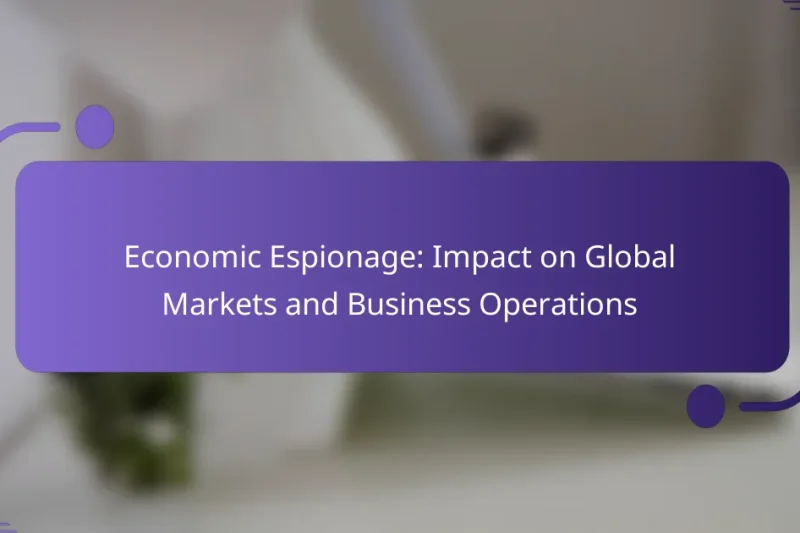In the realm of corporate espionage, Human Intelligence (HUMINT) and Signals Intelligence (SIGINT) serve as two … Human Intelligence vs. Signals Intelligence: Corporate Espionage Applications and StrategiesRead more
Espionage Techniques: Types and Applications
Espionage techniques encompass a range of methods designed to collect sensitive information for various purposes, including corporate advantage and national security. These techniques, such as surveillance, social engineering, and cyber espionage, can lead to significant legal and ethical implications, especially when conducted without consent. Understanding these methods and their applications is crucial for navigating the complex landscape of information gathering in today’s world.
Espionage Techniques: Historical Case Studies and Lessons Learned
Espionage techniques have evolved significantly throughout history, encompassing methods such as human intelligence (HUMINT), signals intelligence … Espionage Techniques: Historical Case Studies and Lessons LearnedRead more
Industrial Espionage Techniques: Protection Strategies for Your Business
In today’s competitive landscape, protecting your business from industrial espionage is crucial. By implementing effective strategies … Industrial Espionage Techniques: Protection Strategies for Your BusinessRead more
Economic Espionage: Impact on Global Markets and Business Operations
Economic espionage poses a serious threat to global markets by undermining competition and distorting fair trade … Economic Espionage: Impact on Global Markets and Business OperationsRead more
What are the most effective espionage techniques?
The most effective espionage techniques include a variety of methods aimed at gathering sensitive information. These techniques can be categorized into surveillance, social engineering, cyber espionage, physical infiltration, and signal intelligence.
Surveillance methods
Surveillance methods involve monitoring individuals or locations to gather intelligence. This can be done through physical observation, using cameras, or employing drones for aerial surveillance. Effective surveillance requires careful planning to avoid detection and may involve the use of disguises or cover stories.
Common tools include binoculars, hidden cameras, and tracking devices. When conducting surveillance, it is crucial to understand local laws regarding privacy and monitoring to avoid legal repercussions.
Social engineering tactics
Social engineering tactics exploit human psychology to gain access to confidential information. This can include techniques like phishing, where attackers impersonate trusted entities to trick individuals into revealing sensitive data. Building rapport and trust is key in these scenarios.
To effectively use social engineering, one must research the target thoroughly, understanding their habits and vulnerabilities. Always be cautious of the ethical implications and potential legal consequences of manipulating individuals for information.
Cyber espionage tools
Cyber espionage tools are software and techniques used to infiltrate computer systems and networks to extract sensitive data. Common tools include malware, keyloggers, and network sniffers. These tools can be deployed remotely, making them particularly effective for gathering intelligence without physical presence.
To mitigate risks, organizations should implement strong cybersecurity measures, including firewalls, intrusion detection systems, and regular software updates. Training employees on recognizing cyber threats is also essential to prevent breaches.
Physical infiltration strategies
Physical infiltration strategies involve gaining unauthorized access to secure locations to collect information. This may include tactics such as tailgating, where an unauthorized person follows an authorized individual into a restricted area, or using fake credentials to gain entry.
Planning is critical; understanding security protocols and timing can significantly enhance the chances of successful infiltration. Always consider the potential consequences of being caught, as this could lead to legal action or damage to reputation.
Signal intelligence (SIGINT)
Signal intelligence (SIGINT) refers to the interception and analysis of electronic communications to gather information. This can include phone calls, emails, and other forms of digital communication. SIGINT is often used by government agencies to monitor potential threats.
To effectively utilize SIGINT, one must have access to advanced technology and a thorough understanding of communication protocols. Compliance with legal regulations regarding surveillance and data collection is essential to avoid violations and maintain ethical standards.
How is espionage applied in corporate settings?
Espionage in corporate settings involves gathering sensitive information to gain a competitive advantage. Techniques vary widely, from legal competitive intelligence to unethical practices that can lead to legal repercussions.
Competitive intelligence gathering
Competitive intelligence gathering focuses on collecting and analyzing information about competitors to inform strategic decisions. This can include monitoring public records, analyzing marketing materials, and attending industry conferences. Companies often use this data to identify market trends, understand competitor strengths and weaknesses, and refine their own strategies.
To effectively gather competitive intelligence, businesses should establish clear objectives and use ethical methods. Tools like web scraping and social media analysis can provide valuable insights without crossing legal boundaries.
Market analysis through infiltration
Market analysis through infiltration involves discreetly entering a competitor’s environment to gather insights on their operations, products, or strategies. This can be achieved through tactics such as hiring former employees or attending trade shows as a customer. While this method can yield deep insights, it carries significant ethical and legal risks.
Companies must weigh the potential benefits against the possibility of reputational damage and legal consequences. Engaging in such practices can lead to lawsuits and loss of trust if discovered.
Employee monitoring practices
Employee monitoring practices involve overseeing staff activities to protect sensitive information and ensure productivity. This can include tracking computer usage, monitoring emails, and implementing surveillance systems. While these practices can enhance security, they must be balanced with employee privacy rights.
Organizations should establish clear policies regarding monitoring and ensure compliance with local regulations. Transparency with employees about monitoring practices can help maintain trust and reduce potential backlash.
What are the legal implications of espionage?
Espionage involves gathering confidential information without consent, often raising significant legal issues. The implications vary widely depending on the jurisdiction and the nature of the information obtained, potentially leading to severe penalties including fines and imprisonment.
International espionage laws
International espionage laws are complex and differ from country to country. Generally, nations have agreements that outline acceptable practices and protections for intelligence operations, but these can be vague and subject to interpretation. Violating these laws can result in diplomatic tensions or legal actions against individuals or governments.
For example, the Vienna Convention on Diplomatic Relations provides some protections for diplomats engaged in intelligence activities, but it does not shield them from prosecution if caught engaging in illegal espionage. Countries like the United States have specific statutes, such as the Espionage Act, that impose strict penalties for unauthorized information gathering.
Corporate espionage regulations
Corporate espionage, or industrial espionage, is often governed by a mix of intellectual property laws and trade secret protections. In many jurisdictions, including the United States and European Union, companies can pursue legal action against competitors that unlawfully acquire sensitive business information.
For instance, the Defend Trade Secrets Act in the U.S. allows companies to sue for damages if their trade secrets are misappropriated. Companies should implement robust security measures and employee training to prevent unauthorized access to sensitive information, as failure to do so can lead to significant legal and financial repercussions.
What are the historical examples of espionage techniques?
Historical examples of espionage techniques reveal a range of methods used by nations to gather intelligence. These techniques have evolved over time, adapting to technological advancements and geopolitical shifts.
Cold War espionage tactics
During the Cold War, espionage tactics included surveillance, wiretapping, and the use of double agents. Both the United States and the Soviet Union invested heavily in intelligence agencies, employing spies to infiltrate each other’s governments and military operations.
One notable tactic was the use of reconnaissance satellites, which allowed for high-resolution imagery of enemy territories. Additionally, the establishment of covert operations, such as the CIA’s involvement in foreign coups, exemplified the aggressive nature of Cold War espionage.
World War II intelligence operations
World War II saw a significant expansion of intelligence operations, with techniques such as codebreaking and signal intelligence becoming crucial. The Allies’ success in breaking the Enigma code used by the Germans is a prime example of how effective intelligence can alter the course of war.
Another key operation was the use of misinformation campaigns, such as Operation Fortitude, which misled the Germans about the location of the D-Day invasion. These tactics highlighted the importance of deception and strategic planning in wartime espionage.
How to choose the right espionage technique?
Selecting the appropriate espionage technique involves understanding your operational goals and assessing the associated risks. The right choice can significantly impact the effectiveness and safety of your mission.
Assessing operational goals
Begin by clearly defining what you aim to achieve through espionage. Common objectives include gathering intelligence, disrupting operations, or influencing decision-making. Each goal may require a different approach, such as surveillance, infiltration, or cyber operations.
Consider the resources at your disposal, including time, personnel, and technology. For instance, if your goal is to gather sensitive information quickly, a cyber approach might be more effective than traditional methods, which can be time-consuming.
Evaluating risk factors
Assess the potential risks associated with each espionage technique. This includes the likelihood of detection, legal repercussions, and the potential for retaliation. Techniques like social engineering may carry lower technological risks but can lead to significant personal or organizational consequences if exposed.
Weigh the benefits against the risks to determine the most viable option. For example, while physical infiltration might yield valuable insights, it also poses higher risks of capture compared to remote surveillance. Always have contingency plans in place to mitigate potential fallout.
What are the emerging trends in espionage?
Emerging trends in espionage highlight the increasing integration of technology, particularly artificial intelligence, into traditional spying methods. These advancements enable more sophisticated data collection, analysis, and operational execution, making espionage more efficient and harder to detect.
Use of artificial intelligence
Artificial intelligence (AI) is transforming espionage by enhancing data processing capabilities and automating surveillance tasks. AI algorithms can analyze vast amounts of data from various sources, identifying patterns and anomalies that human analysts might miss.
For instance, AI-driven tools can monitor social media platforms, intercept communications, and even predict potential threats based on behavioral analysis. This capability allows intelligence agencies to respond more quickly to emerging risks and adapt their strategies accordingly.
However, the use of AI in espionage also raises ethical concerns and potential legal issues, particularly regarding privacy rights. Agencies must navigate these challenges while leveraging AI’s strengths to maintain operational effectiveness.



